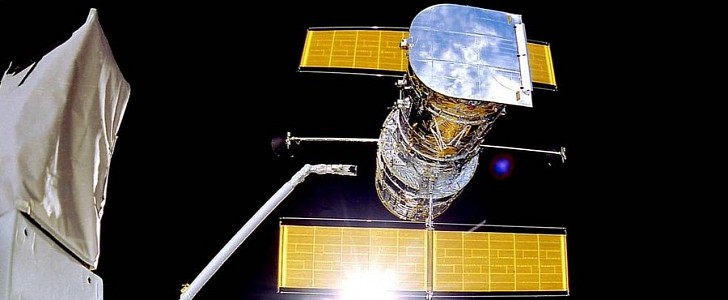Launched back in the '90s, the Hubble telescope, which has been observing planets, stars, and galaxies more than 13.4 billion light-years away from our home, is beginning to show its age. On June 13th, Hubble encountered an issue with the payload computer, and NASA's team of researchers has been trying to solve the problem for more than a week now.
The telescope completed 30 years in operation in April 2020 and, theoretically, it could last for another 20 years in space. However, it's already showing signs of aging. On Sunday, June 13th, shortly after 4 p.m. EDT, Hubble's computer experienced a glitch.
The next day, NASA attempted to restart the computer, but it failed. The agency suspected that the cause of the problem was a degrading computer memory module. However, when the operations team tried to switch to a backup memory module, the command to initiate the backup module also failed.
On Thursday evening, another attempt was made on both modules to gather more diagnostic information while also attempting to bring those memory modules online. Still, the efforts were unsuccessful. NASA's operations team is currently conducting tests and gathering additional data on the system in order to narrow down the source of the issue.
It's not shocking that the computer is experiencing some trouble. Built in the '80s, the payload computer has ever since been through a wild journey. Hubble went into partial safe mode in 2019 due to potential hardware issues with its most advanced instrument, the Wide Field Camera 3. This year, in March, a software issue in the spacecraft's main computer was also discovered and shortly resolved.
Despite the fact that it has been orbiting 340 miles (547 km) above Earth's surface for quite some time now, the module has various levels of redundancy that can be turned on to function as the primary system when necessary. Therefore, we should rest assured – Hubble and its science instruments are still in good condition and will stay in a safe mode until the issue is fixed.
Later this year, Hubble will be joined in space by a new friend, the James Webb Space Telescope (JWST). Unlike its old buddy, Webb will orbit Earth at a greater distance, at approximately 930,000 miles (1,500,000 km), and will provide improved infrared resolution and sensitivity that will allow NASA to peer into the most distant objects in the universe.
The next day, NASA attempted to restart the computer, but it failed. The agency suspected that the cause of the problem was a degrading computer memory module. However, when the operations team tried to switch to a backup memory module, the command to initiate the backup module also failed.
On Thursday evening, another attempt was made on both modules to gather more diagnostic information while also attempting to bring those memory modules online. Still, the efforts were unsuccessful. NASA's operations team is currently conducting tests and gathering additional data on the system in order to narrow down the source of the issue.
It's not shocking that the computer is experiencing some trouble. Built in the '80s, the payload computer has ever since been through a wild journey. Hubble went into partial safe mode in 2019 due to potential hardware issues with its most advanced instrument, the Wide Field Camera 3. This year, in March, a software issue in the spacecraft's main computer was also discovered and shortly resolved.
Despite the fact that it has been orbiting 340 miles (547 km) above Earth's surface for quite some time now, the module has various levels of redundancy that can be turned on to function as the primary system when necessary. Therefore, we should rest assured – Hubble and its science instruments are still in good condition and will stay in a safe mode until the issue is fixed.
Later this year, Hubble will be joined in space by a new friend, the James Webb Space Telescope (JWST). Unlike its old buddy, Webb will orbit Earth at a greater distance, at approximately 930,000 miles (1,500,000 km), and will provide improved infrared resolution and sensitivity that will allow NASA to peer into the most distant objects in the universe.

